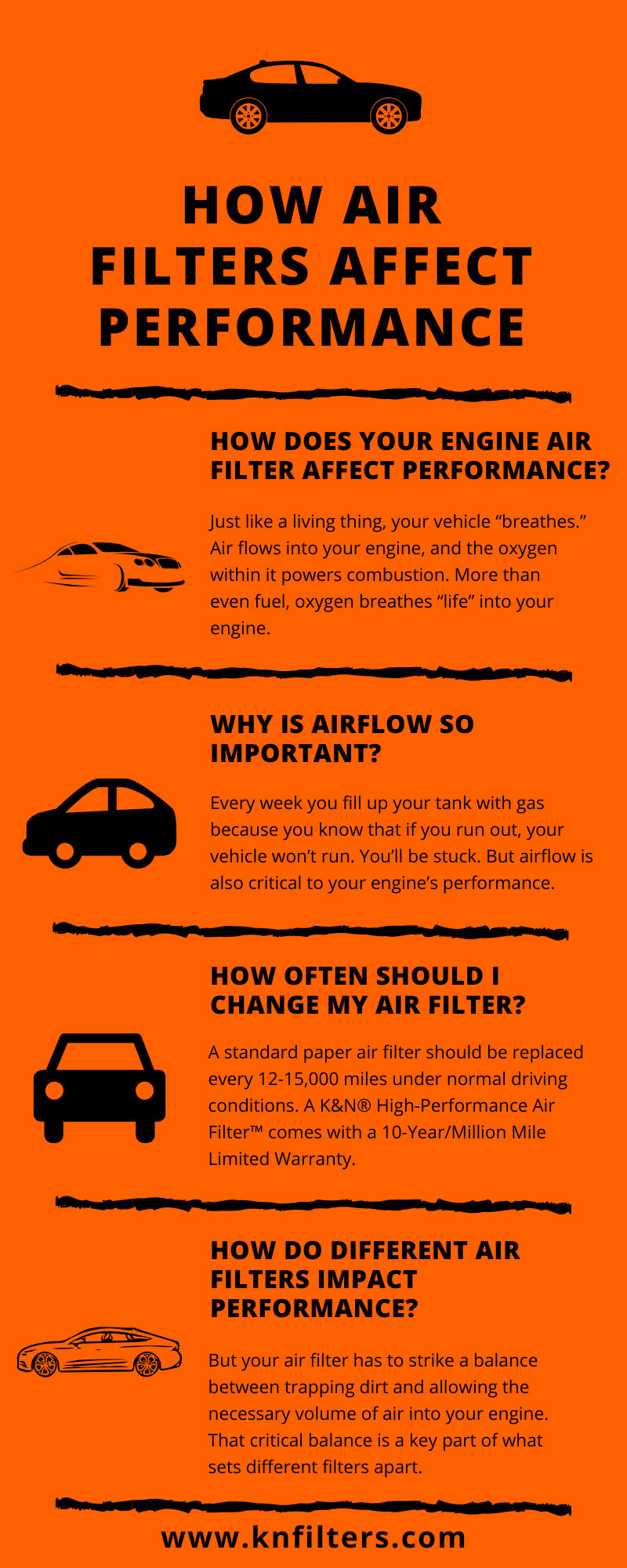We use cookies to make your experience better. To comply with the new e-Privacy directive, we need to ask for your consent to set the cookies. Learn more.
How does your engine air filter affect performance?
Why is airflow so important?
For efficient combustion, your engine needs nearly 15 times more air than gas, which emphasizes the critical importance of an airflow-efficient air filter. A high-performance air filter can help improve airflow and maintain the ideal air-to-fuel ratio, while also protecting your engine from harmful contaminants.How do different air filters impact performance?
Your air filter’s most important job is to protect your engine from dirt and debris, and most filters do that job fairly well. Your air filter has to strike a balance between trapping dirt and allowing the necessary volume of air into your engine. That critical balance is a key part of what sets different filters apart.The stock filter that comes standard in most engines is typically composed of paper. Paper filters are often very inexpensive, but fairly efficient at trapping potential engine contaminants. Disposable paper filters have thousands of tiny pores - or pathways for air - that are excellent at trapping particles that are the same size or larger than their pores. Paper filters are often highly efficient at trapping dirt for that reason, but paper filters have two significant challenges. Firstly, the smallest particles - those smaller even than the paper’s pores - can still flow into the engine where they can cause harm. Secondly, once the filter’s pores are clogged, air no longer flows as freely into the engine - and less air means lower horsepower and acceleration.
In the early 1960s two avid racers, Ken Johnson and Norm McDonald, set out to strike a more consistent and long-lasting balance between filtration and airflow. They turned their frustration with clogged paper filters into a spark of invention, harnessing new materials and technology to create the K&N® High-Flow Air Filter™. Today their innovative filters are trusted by millions of drivers and elite racers worldwide.
Ken and Norm completely re-imagined the essential components of the engine air filter. They started with naturally breathable cotton gauze, woven into a filter 4-6 layers thick. Each porous layer is engineered to trap particles while letting a higher volume of airflow through. Just as with paper filter media, the cotton filter traps particles at the surface, but the cotton filter also traps particles that flow below the surface and into the mesh of filtration layers below. By pairing multiple layers of filtration with a more porous, breathable material, the cotton filter increases airflow while still providing exceptional engine protection.
K&N cotton filters also feature a layer of oil. The tacky oil saturates every fiber of the filter, helping the cotton gauze trap and hold contaminants. Some contaminants are stopped head-on as they collide with the filter. Other particles are slowed and eventually trapped as they graze by the sticky, oiled filter media fibers. The trapped particles get sticky with oil themselves, and soon begin trapping other particles, essentially enhancing the efficiency of the filtration system.
Performance:
Ken and Norm ’s striking design innovation offers high filtration efficiency while increasing clean airflow by up to 50%. For you, that could mean more horsepower and better acceleration from the vehicle you already own — without compromising the long-term health of your engine. And more muscle isn’t just a nice-to-have feature for the racetrack - It can mean you’re safely equipped to handle the surprises of the road, from the highway on-ramp to steep mountain grades.Durability:
One of the most impressive aspects of K&N reusable filters is their durability. Paper filters are, by nature, disposable. Once they’re clogged with dirt and grime, they need to be replaced. K&N oiled-cotton filters are protected by a durable wire screen mesh, and set within a custom-poured and cured urethane frame. They’re engineered to last for a million miles of use, and are built to withstand the demands of elite-level racing. While a paper filter must be frequently replaced, a K&N filter can be cleaned and reused time and time again, performing virtually like new for the life of your vehicle.How often should I change my air filter?
A standard paper air filter should be replaced every 12-15,000 miles under normal driving conditions. A K&N® High-Flow Air Filter™ comes with a Million Mile Limited Warranty. You can drive up to 50,000 miles under normal highway driving conditions before your K&N filter needs to be cleaned. Motorsports enthusiasts, or drivers in highly congested or dusty conditions, should clean their filters more often.Cleaning your High-Flow Air Filter™ with a K&N Recharger® Kit is a quick DIY that requires little active time and no special tools. Simply spray both sides with K&N Power Kleen®, and gently rinse with a low-pressure hose or faucet until the water runs clear. Let your filter air-dry naturally and then apply a coating of red filter oil before re-installing.
Watch this step-by-step video for easy-to-follow directions on how to clean your K&N® High-Flow Air Filter™.
Back to How To Guides






